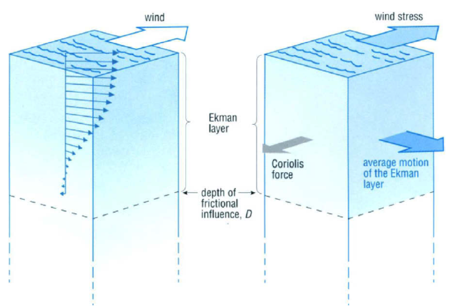Table of Contents
The Great Pacific Garbage Patch
Author: Thomas Egli
The Discovery of the Great Garbage Patch
The Great Pacific Garbage Patch, also known as the Pacific Trash Vortex, was first theorised by researchers with the National Oceanic and Atmospheric Association (NOAA) of the United States. By analysing data from surveys in the temperate North Pacific, high concentrations of marine debris were found to be accumulating in regions governed by ocean currents. A sailor making his way across the Pacific Ocean in 1997 found an extensive area of garbage floating on and near the surface and passed on his observations to oceanographers. Further expeditions throughout the area have found that there are two distinct patches, one in the eastern north Pacific, and the other in the west. In recent years, media coverage has brought further attention to the issue and the resultant affects on wildlife have become a major concern for researchers, conservationists, and international institutions.
Location
Several oceanic garbage patches have been identified, each associated with a different large-scale circulation pattern (Figure 1). The recent events surrounding the search for a missing airliner in the remote south Indian Ocean to the southwest of Australia, for example, demonstrated huge fields of floating debris caught in the Indian Ocean Gyre. In fact, the five major subtropical gyres were predicted to and have been shown to each contain a vast area of garbage.
Figure 1 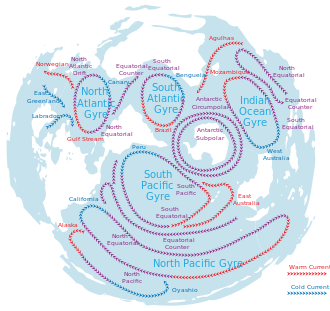 Source: http://en.wikipedia.org/wiki/File:Currents.svg
Source: http://en.wikipedia.org/wiki/File:Currents.svg
The North Pacific Gyre (Figure 2) is a general current pattern of anticlockwise circulation that covers one of the greatest expanses of open water on the planet. Largely driven by wind, the gyre is bounded by the Pacific Equatorial Current system to the south, the Kuroshio current to the west, the North Pacific Current to the north, and the California Current to the east. Together, these currents and associated wind patterns are responsible for the processes that accumulate ocean garbage within the Convergence Zone into two main patches in the east and west of the gyre.
Figure 2 Source: http://en.wikipedia.org/wiki/File:North_Pacific_Subtropical_Convergence_Zone.jpg 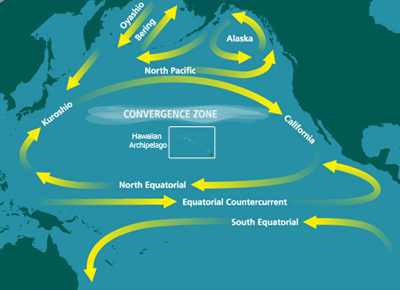
What is the “Patch”?
The common perception of an oceanic garbage patch conjures up images of refrigerators and plastic bottles floating on the ocean, creating a navigational hazard and challenging our perception of a pristine ocean. The reality, however, is a much more subtle effect that explains why the phenomenon was only recently discovered. While it doesn’t break down fully by any natural mechanism, most plastic trash in the ocean floats near the surface, but is normally hidden to the naked eye. Additionally, most of the plastic is mechanically degraded by ocean processes and photodegraded by sunlight, breaking it up into smaller pieces that remain polymers. These tiny pieces of plastic are spread over huge areas. One study found an average of 334,000 pieces of plastic per km^2 of ocean, with a mean mass of 5 kg. This is equivalent to about 8m^2 of plastic per km^2. Although the actual amount of plastic can be quite small, its effects are devastating.
Figure 3. A surface view of the Great Pacific Garbage Patch
Photo by Miriam Goldstein, Scripps Institution of Oceanography, 2010 EX1006 cruise.
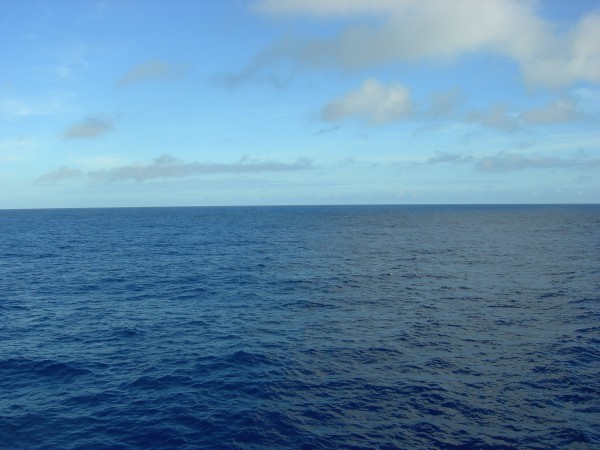
Formation of the Subtropical Gyre
In the northern hemisphere, anticyclonic winds rotate in a clockwise direction. Such winds drive the currents of the North Pacific Gyre. On a large scale, this leads to a mean pattern of surface convergence of water, creating a vast area of net downwelling. The major process responsible for this is the Ekman Pump. Because seawater is relatively incompressible, the net movement of water pushed toward the centre of an area of anticyclonic circulation due to Ekman transport results in the sea surface to slope upwards towards the middle of the gyre. The circulating water will be acted on by a horizontal pressure gradient force. (Figure 4). Balanced by the Coriolis force, the resultant geostrophic current will flow in the same direction as the wind.
Figure 4 Source: Brown, E., Colling, A., Park, D., Phillips, J., Rothery, D., & Wright, J. (2001) Ocean Circulation.
Open University. Page 64. 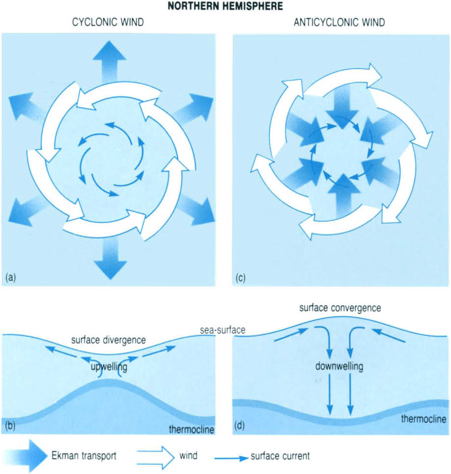
Ekman Transport
Figure 5 shows the net effect of wind stress on the water at the boundary layer of the ocean. The average motion of the Ekman layer is between 45 and 90 degrees to the right of the direction of wind stress. In the Southern Hemisphere, the average motion of the Ekman layer is angled to the left of the wind stress. The motion of water resulting from these effects is known as an Ekman Pump (Figure 6). Within subtropical gyres, the convergence areas are associated with downwelling, which moves water away from the surface. In a similar way, subpolar gyres result in large areas of upwelling because of their associated cyclonic wind circulation, horizontal pressure gradients facing outward, and water being pumped up from below to replace the net movement of surface water away from the centre.
Figure 5. Source: Brown, E., Colling, A., Park, D., Phillips, J., Rothery, D., & Wright, J. (2001) Ocean Circulation. Open University. Page 42.
Figure 6. Source: Münnich, M. Introduction to Oceanography Lecture 9. 16.04.14
Environmental Concerns
Microplastic concentrations in the North Pacific Subtropical Gyre have increased by two orders of magnitude over the past four decades. Although the exact origins of the garbage in the Great Pacific Garbage Patch are uncertain, it is thought that 80% comes from land sources. The range of trash is between huge pieces of discarded fishing nets to micro-pellets used in abrasive cleaners. Aside from entanglement and other direct lethal effects on marine life, invertebrates, fish, and other animals ingest the small pellets, likely mistaking them for food. These plastics cannot be digested and so accumulate in the stomachs of marine animals.
Midway Atoll is an isolated island roughly halfway between North America and Asia and is home to three million seabirds. Nearly all of these have plastics in their stomachs and a third of all chicks die, likely due to starvation as a result of plastic ingestion. Albatross on the island can have up to 50% of their intestinal tracts filled with plastic (Figure 7). On the other hand, large pieces of floating debris can be used as shelter by fish and invertebrates. These provide a temporary home for animals and may locally increase the biomass of otherwise biologically-reduced stretches of ocean.
Figure 7. Source: http://cdn.changemakers.com/sites/default/files/cj.jpg 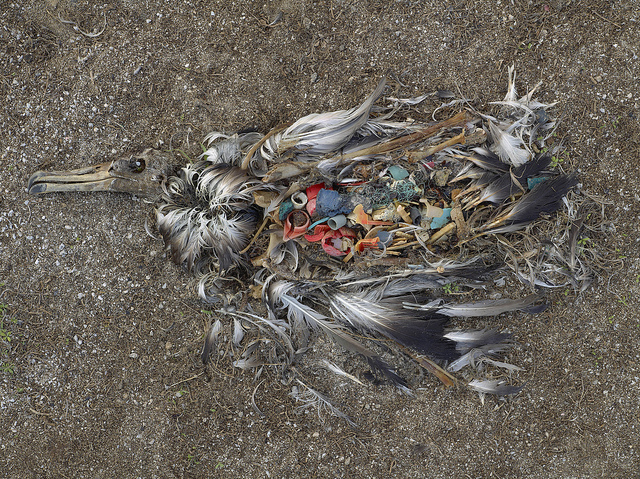
References
- Brown, E., Colling, A., Park, D., Phillips, J., Rothery, D., & Wright, J. (2001) Ocean Circulation. Open University.
- Münnich, M. Introduction to Oceanography Lecture 9. 16.04.14
Comments
Hannah Wey: You mentioned that the plastic items are broken down into smaller fragments, in literature called “micro plastics” with a diameter of less than 5mm. It is not clear yet how these plastic particles impact the nature or humans: It was shown in lab experiments that they can transport hydrophobic contaminants like DDT to remote locations, as a lot of these chemicals are hydrophob as well and therefore attach to the plastic particles that are swimming close to the water surface. Additionally, there are a lot of chemicals in the plastics (additives like stabilisers, plasticisers and so on) that can leach once the plastics reach the environment. Some of these additives are supposed to mimic hormones in organisms (such as bisphenol A). It is not clear yet if plastic particles themselves or the additives accumulate or even biomagnify in the food web and if they can harm animals living in the oceans or even humans.
